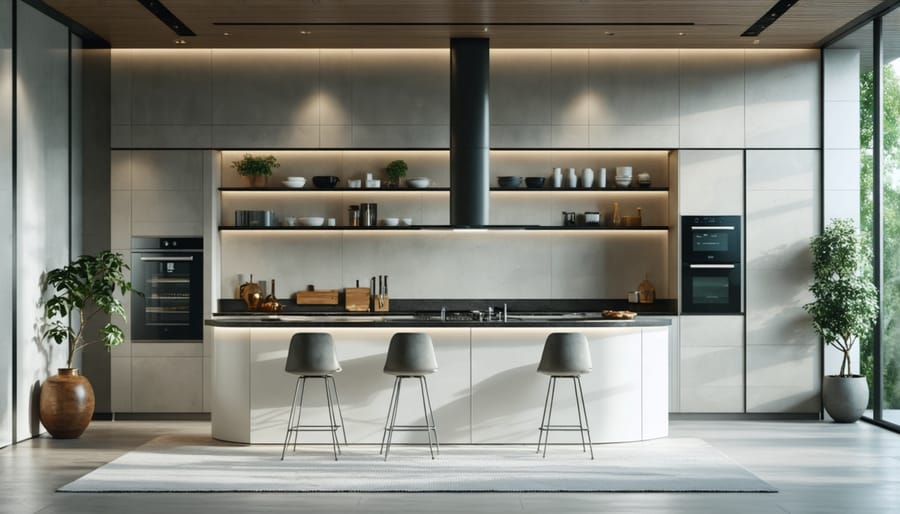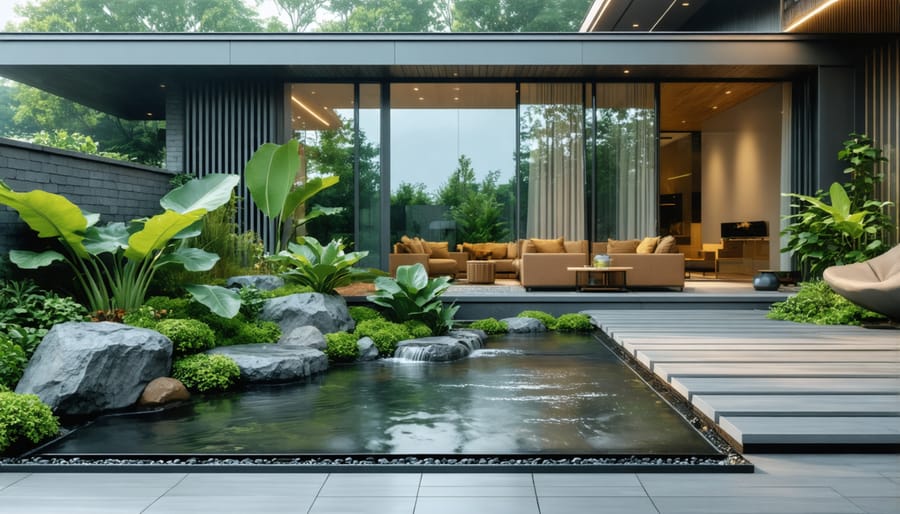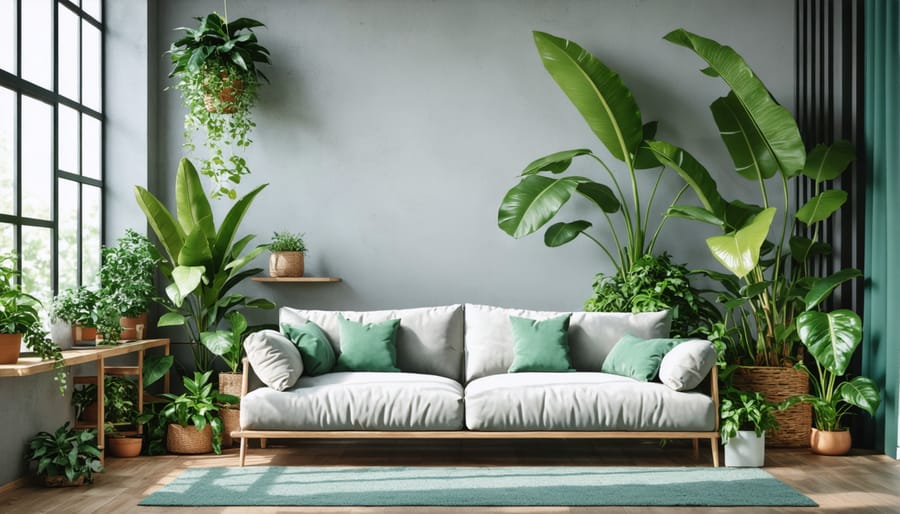Transform your home into an eco-conscious sanctuary by adopting sustainable practices that blend seamlessly with modern living. Start with energy-efficient LED bulbs and smart thermostats in every room, reducing your carbon footprint while maintaining style and comfort. Create a minimalist, zero-waste kitchen using glass containers, reusable produce bags, and a dedicated composting station that turns kitchen scraps into garden gold. Embrace natural cleaning solutions like vinegar, baking soda, and essential oils to maintain a toxin-free environment while saving money and reducing plastic waste.
Replace single-use items with durable alternatives – swap paper towels for washable cloths, plastic wrap for beeswax covers, and disposable sponges for biodegradable scrubbers. Install low-flow faucet aerators and dual-flush toilets to cut water consumption without sacrificing performance. Choose furniture made from reclaimed wood, organic textiles, and recycled materials to create a stylish, environmentally responsible living space that tells a story of conscious consumption.
These practical changes not only reduce your environmental impact but also create a healthier, more intentional living space that inspires others to embrace sustainable living. Every small adjustment contributes to a larger movement toward environmental stewardship while maintaining the comfort and aesthetic appeal of your home.
Smart Energy Solutions for Every Room
Kitchen and Appliance Efficiency
Making your kitchen more sustainable starts with choosing and using appliances wisely. Begin by implementing smart energy efficiency strategies when selecting new appliances – look for those with ENERGY STAR certification, which typically use 10-50% less energy than standard models.
Consider the size of your appliances carefully; an oversized refrigerator wastes energy, while a right-sized one maintains efficiency. When using your dishwasher, wait until you have a full load and skip the heat-dry cycle. Instead, open the door slightly after the wash cycle to let dishes air dry naturally.
For your cooking needs, induction cooktops are remarkably efficient, transferring about 90% of their energy directly to your cookware. Match pot sizes to burner sizes, and use lids while cooking to reduce energy waste. Your microwave can be a great energy-saver for small portions – it uses up to 80% less energy than your conventional oven.
Regular maintenance keeps appliances running efficiently: clean refrigerator coils, check door seals, and descale your kettle and coffee maker. Simple habits like batch cooking, using a toaster oven for small meals, and unplugging small appliances when not in use can significantly reduce your kitchen’s energy footprint while maintaining functionality and style.

Lighting and Climate Control
Creating a comfortable and energy-efficient home starts with smart sustainable lighting solutions and thoughtful climate control. Start by maximizing natural light through strategic window placement and using light-colored window treatments that allow sunlight to filter through while maintaining privacy. Install LED bulbs throughout your home and consider smart lighting systems that automatically adjust based on occupancy and natural light levels.
For climate control, embrace the power of natural ventilation by creating cross-breezes through strategically opened windows. Install ceiling fans to circulate air effectively, reducing the need for air conditioning during moderate weather. Consider adding thermal curtains or cellular shades that trap air between layers, providing extra insulation during both hot and cold seasons.
Plant deciduous trees on the south and west sides of your home to provide natural shade in summer while allowing warming sunlight during winter months. Use draft stoppers under doors and apply weatherstripping around windows to prevent air leaks. Smart thermostats can optimize your heating and cooling schedules, potentially reducing energy consumption by 10-15%.
Don’t forget about zoning your home – close vents and doors in unused rooms and use area-specific heating or cooling when possible. These simple yet effective strategies not only reduce your carbon footprint but also create a more comfortable living space while lowering utility bills.
Water-Wise Home Improvements
Low-Flow Solutions That Don’t Compromise Comfort
Transform your daily water usage without sacrificing comfort by embracing modern low-flow solutions. Today’s water-efficient fixtures have come a long way from their early counterparts, offering powerful performance while implementing effective water conservation practices.
Start with your shower head – newer models use innovative aerating technology to maintain strong water pressure while using up to 40% less water. Look for WaterSense-certified fixtures, which guarantee both performance and efficiency. These modern shower heads can save the average household nearly 3,000 gallons of water annually!
In the kitchen and bathroom, dual-flush toilets and touch-sensitive faucets make saving water intuitive and easy. Smart faucet aerators mix air with water to create a full flow sensation while using just a fraction of the water. Many of these devices can be installed in minutes without calling a plumber.
For outdoor spaces, consider smart irrigation systems that adjust watering schedules based on weather conditions and soil moisture levels. These systems ensure your garden stays lush while preventing overwatering.
The best part? These upgrades often pay for themselves through reduced water bills within the first year, making them both environmentally and financially smart choices for your home.
Gray Water Systems and Rain Collection
Water conservation is one of the most impactful ways to live sustainably, and implementing gray water systems and rain collection methods can make a significant difference. Gray water systems recycle water from your sinks, showers, and washing machines for use in garden irrigation or toilet flushing, reducing your freshwater consumption by up to 50%.
Start small by placing rain barrels under your downspouts to collect rainwater for your garden. These simple systems can save thousands of gallons annually and are perfect for watering indoor plants and outdoor landscapes. For a more advanced approach, consider installing a comprehensive gray water system that diverts used water from your bathroom and laundry to a storage tank.
Before setting up any water recycling system, check your local regulations, as some areas have specific requirements for gray water usage. You can begin with basic DIY solutions like redirecting washing machine water to your garden using food-grade hoses and filters. For rain collection, invest in proper filtration systems and covers to prevent mosquito breeding and debris accumulation.
Remember to use biodegradable, natural cleaning products if you’re planning to recycle gray water, as harsh chemicals can harm your plants and soil.

Waste Reduction and Organization
Stylish Storage for Recycling
Gone are the days when recycling meant unsightly bins cluttering your space. Today’s sustainable home design embraces stylish storage solutions that make recycling both convenient and visually appealing. Consider a sleek divided cabinet system in your kitchen, featuring pull-out bins in neutral tones that blend seamlessly with your cabinetry. These hidden heroes keep sorting simple while maintaining your kitchen’s aesthetic appeal.
For open spaces, explore decorative woven baskets labeled with elegant tags or modern metal containers in copper or brushed steel finishes. These can double as design elements while serving a practical purpose. A popular trend is incorporating multi-tier recycling stations into kitchen islands or utility rooms, complete with bamboo or reclaimed wood sorting systems.
Small space dwellers can opt for vertical solutions, such as wall-mounted sorting units with a minimalist design. These can be disguised behind sliding barn doors or concealed within a pantry. For outdoor areas, consider weather-resistant storage boxes with separate compartments, designed to complement your garden or patio décor.
DIY enthusiasts might enjoy creating custom recycling stations using vintage furniture pieces. An old dresser can be transformed into a charming sorting system, with each drawer designated for different materials. The key is choosing solutions that reflect your personal style while making sustainable practices effortless and enjoyable.
Kitchen and Bathroom Zero-Waste Solutions
Transform your kitchen and bathroom into eco-friendly spaces with these simple swaps that make a big impact. Start by replacing paper towels with reusable cloth alternatives – keep a stack of colorful cotton cloths in an easy-to-reach drawer for quick cleanups. For dish washing, swap plastic scrubbers with natural loofahs or bamboo brushes, which are both durable and biodegradable.
In the bathroom, make the switch to solid shampoo and conditioner bars, which eliminate plastic packaging entirely. Consider using a safety razor with replaceable metal blades instead of disposable plastic razors – not only is it more sustainable, but it also offers a closer shave and can last a lifetime with proper care.
Store-bought cleaning products often come in plastic bottles, but you can easily make your own effective cleaners using simple ingredients like vinegar, baking soda, and essential oils. Keep these in glass spray bottles for a plastic-free cleaning routine.
Replace disposable cotton rounds with washable bamboo or cotton alternatives for skincare routines. For dental care, try bamboo toothbrushes and plastic-free toothpaste tablets or powder. Consider installing a bidet attachment to reduce toilet paper usage while improving hygiene.
Small changes like using soap bars instead of liquid soap dispensers and storing leftovers in glass containers rather than plastic wrap can significantly reduce your daily waste while maintaining a stylish, organized space.
Eco-Friendly Decor and Materials
Natural and Recycled Material Selection
Making mindful sustainable material choices is a cornerstone of eco-friendly living. Start by incorporating natural materials like bamboo, cork, and reclaimed wood into your home. These materials not only add warmth and character but also reduce environmental impact. Look for FSC-certified wood products to ensure they come from responsibly managed forests.
Consider recycled materials for both structural and decorative elements. Recycled glass countertops, for instance, offer stunning aesthetics while giving new life to discarded materials. Salvaged metal fixtures and repurposed furniture pieces can add unique charm while keeping valuable resources out of landfills.
When shopping for textiles, opt for organic cotton, hemp, or linen, which require fewer pesticides and water to produce. For insulation, explore alternatives like recycled denim or sheep’s wool, which provide excellent temperature regulation without harmful chemicals.
Don’t overlook the potential of local materials. Stone, clay, and locally sourced wood typically have a lower carbon footprint due to reduced transportation needs. Plus, they often weather better and require less maintenance over time.
Before purchasing new items, explore secondhand options or consider upcycling existing pieces. Local salvage yards, antique shops, and online marketplaces are treasure troves of sustainable materials waiting to be discovered. Remember, the most sustainable choice is often giving new life to materials that already exist.
Indoor Plants for Air Quality
Looking to improve your indoor air quality naturally? Adding the right houseplants can make a significant difference in your home’s atmosphere while adding a touch of natural beauty. Here are some of the most effective air-purifying plants that are also easy to maintain.
The Snake Plant (Sansevieria) is a champion air purifier, known for removing toxins like formaldehyde and benzene. It’s incredibly low-maintenance and thrives even in low-light conditions, making it perfect for beginners. Another powerhouse is the Spider Plant, which efficiently removes carbon monoxide and other pollutants while being safe for pets.
Peace Lilies are excellent at removing common household pollutants and can reduce mold spores in the air. They prefer indirect light and regular watering, producing beautiful white flowers as a bonus. The hardy ZZ Plant is another fantastic choice, particularly for rooms with limited natural light.
For larger spaces, consider the Rubber Plant or Ficus, which can grow into stunning statement pieces while filtering indoor air. The Boston Fern is particularly effective at removing formaldehyde and acts as a natural humidifier – perfect for dry indoor environments.
Pro tip: Place at least one air-purifying plant every 100 square feet for optimal results. Remember to dust the leaves regularly to maximize their air-cleaning efficiency, and keep them healthy with proper watering and occasional fertilizing. These green companions not only clean your air but also bring a touch of nature indoors, creating a more sustainable and healthier living space.

Living sustainably isn’t just about making big changes – it’s about taking small, meaningful steps that add up to significant impact. Throughout this guide, we’ve explored various ways to transform your home into an eco-friendly haven, from energy-efficient lighting choices to sustainable furniture selections. Remember, every sustainable choice you make, no matter how small, contributes to a healthier planet and a more mindful way of living.
Start by implementing one or two changes that resonate most with you. Perhaps begin with simple swaps like switching to LED bulbs or starting a small herb garden in your kitchen. As these habits become second nature, gradually incorporate more sustainable practices into your daily routine. The key is to make changes that feel manageable and authentic to your lifestyle.
The journey to sustainability is personal and ongoing. Don’t feel pressured to overhaul your entire life overnight. Instead, celebrate each eco-friendly decision and learn from the process. Your home can be both beautiful and environmentally conscious, proving that style and sustainability go hand in hand.
Take action today by choosing just one sustainable practice to implement this week. Whether it’s setting up a recycling station or switching to natural cleaning products, your journey toward a more sustainable lifestyle starts with that first step. Together, we can create homes that not only look beautiful but also contribute to a better future for our planet.
